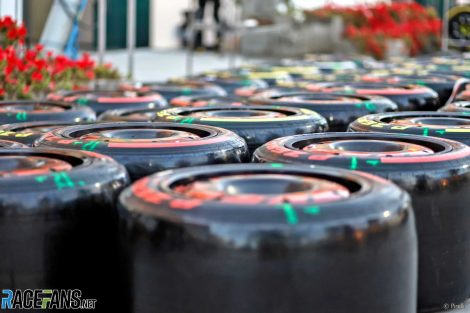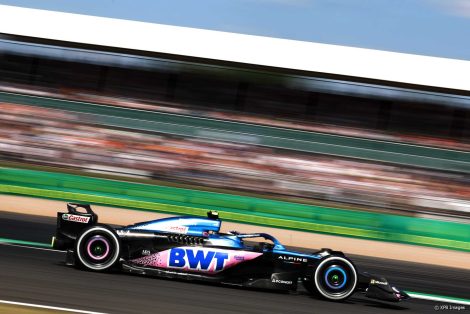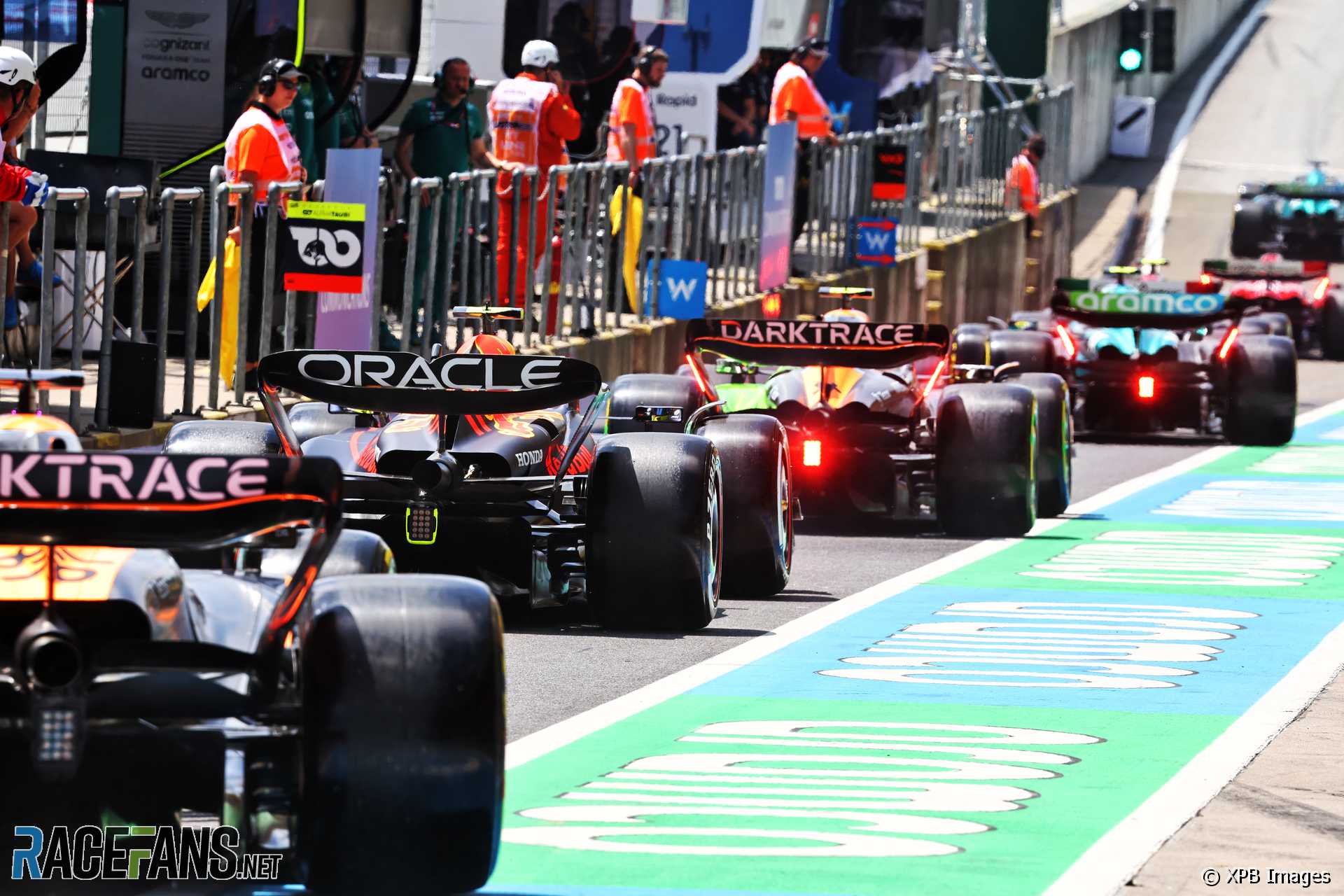There will be a change to the qualifying format at the Hungarian Grand Prix, with a new rule that will only be used at two events in 2023.
The Alternative Tyre Allocation (ATA) was supposed to be used at the Emilia Romagna Grand Prix, which was cancelled. So its first use will be this weekend at the Hungaroring.The rule reduces how many tyres each driver has available during the weekend and mandates which tyre compounds they must use in each segment of qualifying, assuming the session is dry.
Normally only the softest compounds nominated for a weekend appear during qualifying. The fastest teams often attempt to use fewer sets in the early stages, saving more of the softest rubber for the pole-deciding Q3 shootout. But that option won’t be available this weekend as the rules specify hard tyres only for Q1, mediums for Q2 and softs for Q3.
Mandating compound selection has already been trialled in qualifying for the sprint race in Baku. It was supposed to be used again in qualifying for the sprint at the Red Bull Ring but wet weather prevented that.
Outside of sprint race weekends teams ordinarily pick their tyres for qualifying from the 13 sets that are allocated for each car. But during this first ATA weekend, and for the second at September’s Italian Grand Prix, that is reduced to 11 sets. That means 160 fewer tyres will be transported to and from these two events compared to a regular weekend.
As usual teams have no say over which compounds they receive. Each driver will have four sets of the soft compound (which this weekend is the softest C5 option), four of the medium (C4) and three of the hard (C3). By the time they reach qualifying they will have eight sets to choose from per car as one set of tyres are to be returned to following each Friday practice session, two fewer than on a normal weekend.
Advert | Become a RaceFans supporter and
While the full implications of the rule change for a race weekend are yet to be discovered, it has generally been received positively by teams who see more than just the sustainability benefit.

“But it’s just about how you adapt to understanding the different tyres and try to give the drivers good enough practice on the different compounds before qualifying and still have the good race tyres. That’s the challenge for everyone. I think it’s interesting to do stuff like that.”
Ferrari team principal Frederic Vasseur believes F1 should vary its rules more often. “Very often we are too shy and too conservative on the format,” he said.
“It was an option that we discussed last winter in order to have new options for the future, and I think it makes sense to do it and we have to try.”
Williams have made four appearances in Q3 across the first ten rounds of 2023, but on two occasions have got neither of their cars beyond Q1. Team principal James Vowles admitted some uncertainty on how the change in rules might affect their performance.
Advert | Become a RaceFans supporter and
“The idea is good. I’m not sure what it’s going to do. There’s always a little bit of concern, where you’re slightly on the slower side. Is it going to be as easy to get the harder tyres to work? Are we actually going to split the field out? But the concept of trying it is exactly why we are doing it,” Vowles said.

“On that harder tyre in the first session, you’ll be able to not just get one lap out of it, as is the case perhaps in Silverstone with the soft tyre, but multiple laps so you’ll see more cars going around the track, more laps being completed. That’s probably positive for the sport, a positive outcome for it.
“But will it make a bigger gap or make it more predictable? I’m unsure yet, which is exactly why we’re running it as a format. So I’m open minded, it might present a new direction of travel.”
As this year’s nominated tyre compounds for the Hungaroring are a step softer than last year, direct comparisons with what teams did 12 months ago won’t be possible. However the appearance of harder rubber earlier in qualifying is likely to mean we see more continuous laps being run as drivers build up their tyre temperatures.
That could complicate matters for the teams. It may be harder to judge which drivers are on flying laps, making it harder to avoid impeding. The knock-on effect of that could be more variability in the grid and potentially a few more penalties.
However as with the sprint race format the teams are prepared to try a change. “The key word here is open-mindedness,” said Aston Martin team principal Mike Krack, who agreed with Vasseur and Vowles that F1 needs “to try different things.”
Become a RaceFans Supporter
RaceFans is run thanks in part to the generous support of its readers. By contributing £1 per month or £12 per year (or the same in whichever currency you use) you can help cover the costs of creating, hosting and developing RaceFans today and in the future.
Become a RaceFans Supporter today and browse the site ad-free. Sign up or find out more via the links below:
Advert | Become a RaceFans supporter and
2023 Hungarian Grand Prix
- Was F1’s Alternative Tyre Allocation test successful? Drivers and teams have their say
- How far can McLaren climb with car rivals now say is the second-fastest in F1?
- Why Ricciardo says McLaren’s car “speaks Lando’s language” – but Norris disagrees
- Mercedes reveal cooling error behind loss of pace in Hungarian GP
- Perez answered critics in Hungary but needs to qualify better – Horner





Jere (@jerejj)
20th July 2023, 7:25
Experimenting is always good & I don’t see how this alternative hard-Q1/medium-Q2/soft-Q3 pattern could fail, so I wouldn’t mind if this became the standard from next season or at least 11 as the standard set amount for all events.
Btw, I was unaware of Monza being chosen as the effective replacement for Imola because no reporting on this has appeared, but oh well.
SteveP
20th July 2023, 8:47
Not sure what you’re referring to, as Monza and Imola were both on the calendar from the beginning. WRT to the ATA, I can’t recall whether they specified all the races that it would be tried.
Jere (@jerejj)
20th July 2023, 14:10
SteveP – Monza off the calendar? I don’t get what you mean.
Imola & Hungaroring were the two choices, with Imola apparently getting replaced by Monza for this purpose, which is what I meant, but was surprised that no mention of this had appeared until this article.
SteveP
20th July 2023, 19:13
ON was the word I used. “Monza and Imola were both on the calendar from the beginning.”
” WRT to the ATA, I can’t recall whether they specified all the races that it would be tried.”
Jeanrien (@jeanrien)
20th July 2023, 9:15
Reducing the number of tires is definitely a good step especially that it should not have a big impact.
You can see it with glass half empty and missing the opportunity for smaller team to surprise with a run on soft to make it.
Or glass half full, when a surprise team will make it, they have a better shot at a good position as they have same tire available than the others, not just old rubbers.
I personally prefer the glass half full, it gives less avantages to teams with margin in hand, also emphasise to have a car working across the compounds leading to eventually more mixed strategies during races.
BasCB (@bascb)
20th July 2023, 11:30
I don’t think that is actually true @jeanrien – I would actually argue the opposite.
If a team that is faster can just go on a harder set, or try to use the same set of tyres for a second run. That gives somewhat slower teams the option to go for a new set of softs to get ahead of nominally faster cars – sure, they use them and won’t have them later, BUT if they can get through they are still better off being into the next stage.
If the cars are all on the same tyres, and everyone has the same amount, it will only lessen strategy (going on used tyres, going on a harder compound to save tyres for later, go for a 3rd run on fresh softs etc) and make it even more likely we end up with a “noach’s arch” grid lined up from fasterst to slowest chassis.
Paul
20th July 2023, 8:02
I think this will actually make the qualifying MORE predictable since using softer tires earlier was more a way for slower teams to occasionally surprise faster teams who are trying to qualify on harder tires to save softs for later.
Now everybody is going to be on the same tire so Q1 will be a lot more predictable.
DB-C90 (@dbradock)
20th July 2023, 10:58
This exactly.
By all means limit the tyres, but give the teams a choice of when they use them.
BasCB (@bascb)
20th July 2023, 11:31
Yeah, I expect exactly that to happen too @dbradock, Paul.
Jere (@jerejj)
20th July 2023, 14:13
Paul – Everyone already uses the same compound throughout qualifying regularly anyway since the rule about the top 10 qualifiers having to start on the set used for their fastest Q2 laps got dropped.
Esploratore (@esploratore1)
20th July 2023, 23:20
Exactly, not sure how people forgot that, I preferred back when teams would try qualifying on harder tyres.
MichaelN
20th July 2023, 8:09
More cars on track, less wasted rubber, and more fun penalty controversy as well. Sounds like a good idea!
The only downside as mentioned would be that nobody gets caught out by a late run on soft tyres. But then again, how many people really care if an Alfa or Williams is 14th or 16th.
Stephen Crowsen (@drycrust)
20th July 2023, 8:36
I think I read somewhere that if a driver flat spots a tyre or gets a puncture then all four tyres have to be changed, not just the one or two that have been flat spotted or become deflated. This is going to cause more frustration with just 11 sets of tyres than when there were 13 sets of tyres per driver. Nevertheless, I think this is an idea worth trying.
Jere (@jerejj)
20th July 2023, 14:15
@drycrust I don’t think so, especially for those that regularly get eliminated in Q1, so two fewer overall sets for a race weekend won’t really make a difference in this regard.
11 is perfectly okay for five sessions.
Bullfrog (@bullfrog)
20th July 2023, 9:30
Well, we won’t get to see what Ricciardo can do this weekend – chances are he’ll be eliminated without a flat-out soft run to compare with the drivers who make the top 10.
I wish they’d also drop the fastest-lap point (which rewards wasteful use of tyres) and get the crook out straight away for any driver dawdling dangerously slowly around the end of the lap. No arguments, you’re out of qualifying, same as if you’d binned it.
Jere (@jerejj)
20th July 2023, 14:18
@bullfrog How is attempting the fastest lap towards the end a wasteful use of tyres?
Tyres are intended to be used for driving, so making a set but never using it for its intended purpose is wasteful, if anything, rather than using, either a previously unused set or a slightly used one from qualifying.
Coventry Climax
20th July 2023, 11:43
First of all, having different tyre compounds is just the FIA’s way to fake multiple tyre manufacturers.
Secondly, if their goal really is to bring down the amounts of tyres used, either altering the compounds created, or simply altering the rule that determines how many are availble to the teams would have done the trick. Remember it’s the FIA themselves that mandated these different compounds and fast degrading tyres in the first place. Even just dropping the softest of the five compounds altogether, would have had an impact on numbers of tyres used.
What they’ve done now, will result in more boredom, for very, very obvious reasons.
Again, the FIA first creates a problem, so they can come up with a stupid solution later, yet claiming it’s fantastic and everybody wants it.
Obviously, my choice would have been to bring in a second supplier, but leave the teams free to choose which tyres to use; compound AND make, during any part of any session. And then mandate the use of less tyres.
Seems to me, the FIA is looking at things upside down, starting with the word ‘pinnacle’. F1 used to be a technology race too, but that aspect of it couldn’t get much lower anymore.
I sincerely doubt that bringing down the amount of tyres used, is the actual goal, as they’ve chosen the most stupid way to adress it. Plus, with the FIA, there’s usually a hidden agenda.
I sincerely doubt ‘the teams’ really think this is worthwile. But they can’t say that, as the FIA mandates everone to not bring the sport and it’s governing body in ‘discredit.’
I’m so sick of the FIA constantly meddling with everything for no reason. And I’m so sick of the FIA constantly coming up with fake reasons in order to constantly meddle with things.
MichaelN
20th July 2023, 13:10
There is only so much they can change mid-season given that, as you note, the tyres are designed to only last a tiny amount of laps. Bringing the number down a bit and mandating the use of the hardest compound is about the best they can do.
Ciaran (@ciaran)
20th July 2023, 11:49
I think this trial is worth a shot. Within the confines of the existing tyre regulations, it looks like a reasonable way to reduce tyre use without negatively affecting other aspects of the sport. I’m hoping that Q1 hards / Q2 mediums / Q3 softs ends up being an interesting way of differentiating the sessions without unbalancing them too much. And if it doesn’t work then they can easily drop the experiment.
bull mello (@bullmello)
20th July 2023, 14:31
Maybe it should be interesting. Not messing with the well versed qualifying procedure, but only the tires used in each segment. Wondering about which teams could benefit, or other teams could adversely affected. We will see.
Mark Zastrow (@markzastrow)
20th July 2023, 16:46
The sustainability argument is a compelling one considering the increasing number of studies that demonstrate tyre (and brake) wear releases particulate matter and accounts for a significant amount of PM pollution from road cars — sometimes much more than the exhaust itself. I’d be fascinated to see a study of race cars to see how those relative emissions scale.